Did You Know that Tutankhamun Was Buried in Not One but THREE Golden Sarcophagi? with the innermost coffin made of 110.4 kg of solid gold.
The discovery of the tomb of King Tutankhamun in 1922 by Howard Carter and his archaeological team was highly significant due to the intact nature of the tomb. Entering the tomb, the team found four gilded shrines – one nested within the next in order of decreasing size, much like Russian nesting dolls.

Inside of the innermost shrine were three coffins in the shape of a human body, painted with the likeness of the deceased pharaoh mummified within. The paintings allowed the deceased to have a face in the afterlife, making them highly important in the Egyptian religion. Along with the painted likeness of King Tut, the sarcophagi had paintings of other deities along with other adornments, showing the prevalence and prestige of the ruler. Inside of the three coffins laid the preserved body of the king along with his famous golden death mask.
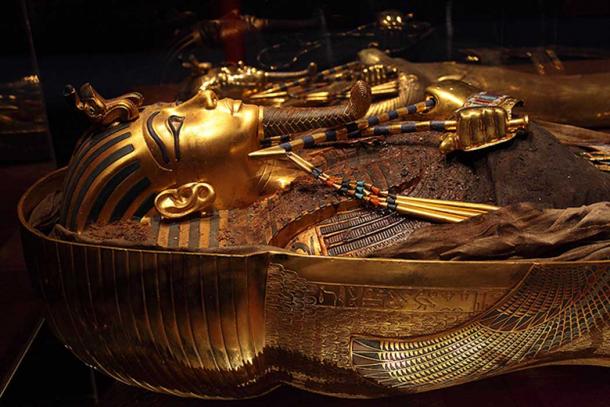
The third, innermost coffin held King Tut’s mummy, covered with an ornate mask and other trappings of his status. Source: Theodor Oskar Krath/R. Boyer
The Outer Coffin
King Tutankhamun’s outer coffin measures 2.24 meters (7.35 ft.) long and its head is positioned to the west. The coffin rests on a low bier that shockingly survived 3,200 years under the strain of the one and a quarter tonne weight of the sarcophagi. The lid and the base were covered in rishi, a feather decoration executed in low relief.
- Everyone Knows the Mask of King Tut, but Have You Seen Any of the 5,000 Other Treasures from His Tomb?
- Enigma of the Heartless Pharaoh: Who Stole the Heart of King Tut, and Why?
- Tomb Hidden by History, Now Revealed: Wet Nurse of Tutankhamun May have been His Own Sister
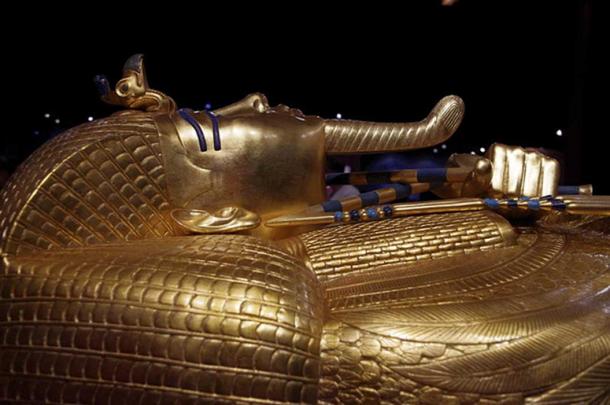
The outer coffin. (CC BY SA 3.0)
On the left and right were engraved images of the deities Isis and Nephthys with their wings extended. At the bottom of the coffin, under the foot, is another depiction of the goddess Isis in a kneeling position; below this are ten vertical lines of hieroglyphics used as a sort of protective charm for the entombed king. Chippings from the coffin revealed that it was made from cypress wood with a thin layer of gesso, or primer, overlaid with gold foil.
The gold overlay varied in thickness and colour over the surface of the coffin; thicker and paler sheets were used for the face and hands as opposed to elsewhere on the body. In the words of Howard Carter, this variance in thickness and colour gave, “an impression of the greyness of death.” King Tutankhamun himself is depicted in the image of Osiris – clutching the twin symbols of kingship, the crook and the flail. The original design of the coffin lid incorporated four silver handles, still intact at the time of discovery, Carter and his team used them to pry open the first sarcophagus to reveal what awaited them below.
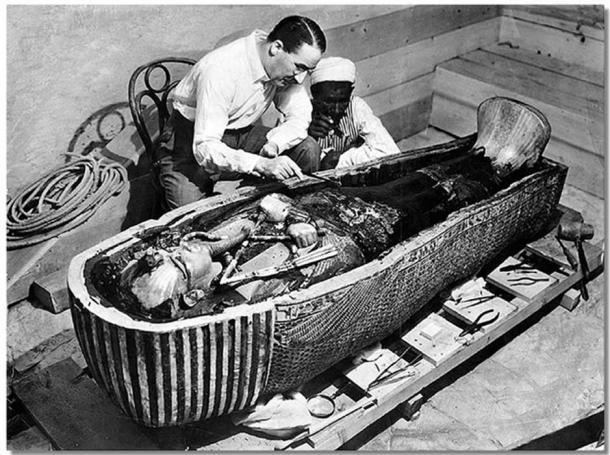
Howard Carter opens the innermost shrine of King Tutankhamun’s tomb near Luxor, Egypt. (Public Domain)
The Second Outer Coffin
Using the silver handles, the archaeologists removed the first coffin’s lid to reveal another coffin hidden underneath. The second coffin measures 2.04 meters (6.69 ft.) long and is made from a yet to be identified wood covered in the same gesso as the first coffin, overlaid with another gold foil layer. The inlays were far more extensive than the outer coffin, even though they have suffered due to the dampness within the tomb and therefore show some damage.
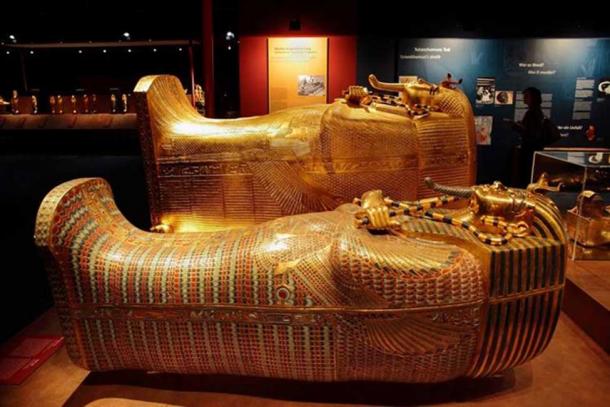
Reproductions of the two outer coffins. (Theodor Oskar Krath/R. Boyer)
A technique known as Egyptian cloisonné work was used on this coffin. This technique involves narrow strips of gold being soldered to the base of the sarcophagus to form cells in which small pieces of coloured glass can be cemented on. As with the outer coffin, a rishi pattern covers the entire surface of the king’s body, although here the feathers are inlaid with jasper-red, lapis-blue, and turquoise glad.
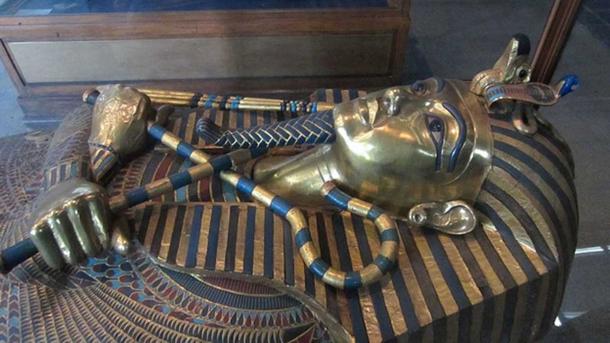
Detail of the head and hands of the middle coffin. (A. Parrot/CC BY SA 4.0)
Replacing the images of Isis and Nephthys are the images of the winged vulture goddess Nekhbet and the winged Wadjet, these images are also inlaid with pieces of red, blue, and turquoise glass. Unfortunately, unlike the first coffin, there were no handles attached to the lid of this coffin. In addition, there were ten gold-headed silver nails holding the lid in its place. However, Carter and his team persisted and removed the lid to reveal the third and final sarcophagus of King Tutankhamun.
- Debate Surges in Place of Discovery in Tomb of Tutankhamun
- Scanning Mummies – What Has Modern Technology Revealed About the Family of Tutankhamun?
- Tutankhamun Death Mask was Made for Nefertiti, Archaeologist says
The Innermost Coffin
The innermost coffin was certainly a spectacle to behold. When the lid of the second sarcophagus was finally lifted, it revealed a human image much like the first two, however, this one was made from solid gold. The golden coffin measures 1.88 meters (6.17 ft.) in length and the metal used to form the shape was hammered from heavy gold sheet in thicknesses varying between 0.25 and 0.3 cm (0.1 – 1.18 inches).

Tutankhamun’s tomb, innermost coffin – gold with inlay of enamel and semiprecious stones. (Egyptian Museum, Cairo)
In 1929, the sarcophagus was weighed at 110.4 kgs (243.39 lbs.), thus its scrap value at that time would have been 1.7 million USD. As in the first two coffins, the image of the king lays with his arms crossed holding the crook and flail. However, the inlaid materials are much more rich on this coffin. The eyes are inlays of calcite and obsidian, the eyebrows and cosmetic lines are lapis-lazuli coloured glass.
At the neck of the coffin were placed two heavy necklaces of disc beads made of red, yellow, and blue faience. Underneath the hands of the king, the goddesses Nekhbet and Wadjet, made from gold sheet and inlaid red-backed quartz along with lapis and turquoise coloured glass, spread their wings protectively around the upper body of the king. In their talons they each grasp the Egyptian Hieroglyph for “infinity.” The goddesses Isis and Nephthys are also present again on the rishi background, much like in the two previous coffins. Like the outermost coffin, the innermost was fitted with four handles which made the lid easier to remove. Thus, at long last, “The lid was raised by its golden handles and the mummy of the king disclosed.”

Tutankhamun’s innermost coffin. (Jon Bodsworth)
Related Post
A shocking documentary proves that mermaids do exist
SHOCKING Revelation: Thuya, Mother of Queen Tiye, Was the Grandmother of Akhenaten and Tutankhamun—What Ancient Egyptian Secrets Did She Leave Behind?
Breaking News: Astonishing Discoveries at Karahan Tepe Confirm an Extraterrestrial Civilization is Hiding on Earth, and NO ONE Knows!
Breaking News: Researchers FINALLY Discover U.S. Navy Flight 19 After 75 Years Lost in the Bermuda Triangle!
NASA’s Secret Investigation: Uncovering the Astonishing Mystery of the UFO Crash on the Mountain!
Explosive UFO Docs LEAKED: Startling Proof That Aliens Ruled Ancient Egypt!